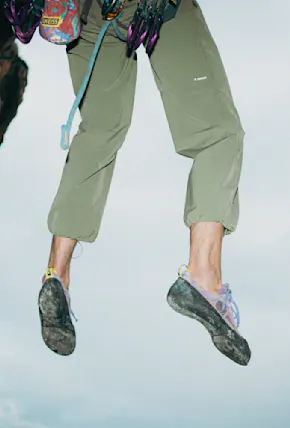Cory Smith is a Santa Barbara, CA-based athlete, online running coach, and freelance journalist specializing in running, climbing, and fitness-related content and gear review. He draws from over 25 years as an elite runner and rock climber for ideas, inspiration, and expertise.
Bouldering is the purest form of rock climbing. And the most accessible. You’re not burdened with ropes, harnesses, or quickdraws. Routes are short, intense, and powerful. And all you need is a pair of climbing shoes and a chalk bag (a working understanding of key climbing lingo helps, too).
But bouldering at your limit means no room for error. Each foot placement, toe smear, and heel hook must be perfectly placed. The tiniest release of tension or foot misplacement could mean the difference between sending your dream project—that's bouldering speak for a specific route—or laying flat out on the crash pads. The right pair of rock climbing shoes can determine whether you succeed or fail; after all, shoes are 50% of your contact with the rock.
Fingers of steel go a long way, but footwork becomes a limiting factor at some point. Enter: the bouldering shoe.
What to Look for in Bouldering Shoes
Sorting through the masses of climbing shoes to find the perfect bouldering shoe is not an easy task. Differences in stiffness and shape significantly impact how a rock climbing shoe performs on different angles and types of rocks. Knowing the attributes that make one shoe more suitable for a particular kind of climbing versus another is essential. Here’s what you need to know.
Stiffness
The most crucial factor to consider when buying a climbing shoe is undoubtedly the stiffness. How soft or stiff a rock climbing is affects how the shoe will stick to the rock.
For example, super soft shoes conform to the shape of the rock, allowing for more rubber to touch the rock, which is perfect for volumes, smears, and toe hooks. On the other hand, a soft shoe will collapse if you’re trying to edge. Stiffer climbing shoes are better at edging because they have some structure your foot can stand on, which makes them better for edging and crack climbing. A simple way to measure the stiffness of a climbing shoe is to determine if it easily folds over on itself. Soft shoes will bend like a taco, stiff shoes won’t.
Of course, the fit of a shoe is important too—high and low volume shoes are available, to ensure peak performance, whether training at the climbing gym or projecting at your local outdoor crag.

Photo courtesy So iLL
Shape
Climbing shoe shapes vary to perform better on specific types of terrain such as steep, vertical, or slab climbing. The four most common shapes are aggressive downturned, slightly or moderate downturned, flat, and asymmetrical.
Aggressive Downturned
These are climbing shoes with a sharp downturn through the toe. The curved forefoot allows for better toe-in power in steep terrain because it acts as a hook on the foothold. Aggressive downturned shoes are best used only for very steep bouldering.
Moderate Downturned
Moderately downturned shoes are similar to aggressive downturned shoes in that there is a curved forefoot through the toe, but the degree to which it is downturned is minor. These shoes tend to be the most versatile, excelling in vertical to steep overhanging climbing.
Flat
Flat shoes are what you expect them to be—flat. This style is best suited for beginner climbers and vertical climbing.
Asymmetrical
This is when the toe of the shoe curves inward, so if you were to draw a straight line from the heel to the toe, the toe would off-center inwards. This curvature allows more power to be placed on your big toe and along the outside edge. Highly asymmetrical lasts are most commonly found in aggressively and moderately downturned shoes, whereas flat lasted shoes tend to be more symmetrical.
Lace-up, Velcro, or Slipper
Climbing shoes come in three different enclosure methods: lace-up, velcro, and slipper. Due to the frequent cycle of climbing followed by resting, climbers find themselves taking off their shoes more when bouldering than when sport climbing or trad climbing. For easy on/off, we recommend going with a velcro closure system or slipper climbing shoe over a lace-up.
The 10 Best Bouldering Shoes, Tested & Approved

Scarpa Booster
Best Bouldering Shoe: Scarpa Booster
After testing dozens of bouldering shoes, the Scarpa Booster quickly emerged as my prized pair of go-to shoes when it mattered most. The Booster excels on steep, demanding bouldering projects while also holding an edge surprisingly well with an aggressive downturn and an asymmetric shape. It’s the one bouldering shoe that can move over rock with the precision of a surgeon’s scalpel, regardless of the angle. The Ceramic microsuede and Alcantara upper is soft and conforms to many foot shapes for a snug fit while holding arduous heel and toe hooks securely. Meanwhile, Scarpa’s trademarked DTS-Tension rand prevents excess wear from degrading the integrity of the shoe’s original shape over time. It might be a high-end rock climbing shoe, but it’s worth every penny, I’d say.
Women's Option: Unisex
Price: $209
SHOP NOW

Evolv Geshido Velcro
Best All-Around Climbing Shoe: Evolv Geshido Velcro
A jack of all trades, the Evolv Geshido Velcro scored exceptionally well in every type of climbing, from techy face problems at outdoor crags to steep jug hauls while gym climbing. Its versatility as an all-around climbing shoe makes the Geshido Velcro an excellent option for the intermediate climber looking to break-in new V-grades or the expert climber looking for a durable gym shoe. The thick 4.2mm of Evolv’s sticky TRAX SAS outsole is not the most sensitive, but in terms of durability, it’s top-notch. You’ll get a ton of climbing in before blowing through the rubber sole. Its unlined vegan-friendly synthetic upper doesn’t stretch much, so don’t size down too much.
Women's Option: YES
Price: $160
SHOP NOW

Black Diamond Momentum
Best Bouldering Shoe for Beginners: Black Diamond Momentum
If you’re just getting started with bouldering or looking for an all-around comfortable entry-level rock climbing shoe, the Black Diamond Momentum is our top pick. The BD Momentum checks all the boxes a beginner rock climbing shoe should: it's inexpensive, comfortable, and durable. Best suited for near-vertical climbing, the neutral, flat last is everything new climbers need and nothing they don’t. Two velcro straps allow easy on/off, while the knit upper with soft inner liner provides all-day comfort. The extra durable 4.3mm of sticky rubber withstands abnormal wear from poor footwork.
Women's Option: YES
Price: $100
SHOP NOW

Scarpa Force V
Most Comfortable Climbing Shoe: Scarpa Force V
Let’s face it—climbing shoes are inherently uncomfortable. Between trying to squeeze into a smaller than normal shoe size and the tiny, stiff toe boxes, it often seems like the less time you can spend in your climbing shoes, the better. While it’s not the most high-performing shoe, the Scarpa Force V is hands down the most comfortable rock climbing shoe on the market. The heavily padded upper with suede finishing feels more like a comfortable bedroom slipper than a rock climbing shoe. My feet have been shoved into all shapes and kinds of climbing shoes, and for an all-day comfortable shoe, I have yet to find a better choice.
Women's Option: YES
Price: $149
SHOP NOW

La Sportiva Skwama
Best Climbing Shoe for Wide Feet: La Sportiva Skwama
When the La Sportiva Skwama first hit the market, it quickly became a favorite among hard boulderers. Those who found the Solution stiff and were looking for something softer with a more forgiving fit flocked to the Skwama. Designed like a slipper with a single velcro strap for an adjustable fit, the Skwama excels in the steeps and on climbing routes that require a shoe with a high degree of sensitivity. Out-of-the-box, the microfiber and unlined leather upper felt a little stiff. However, after a few sessions, it started to show its true colors— which are vivid shades of comfortable and form-fitting. My wide-footed tester agreed that they were a tight fit at first, but started to stretch out to accommodate a broader foot. Bottom line, if you’re looking for a high-performing bouldering shoe with a bit of extra volume, these are for you.
Women's Option: YES
Price: $170
SHOP NOW

Scarpa Vapor V
Best Climbing Shoe for Narrow Feet: Scarpa Vapor V
Like the Evolv Geshido Velcro, the Scarpa Vapor V doesn’t sacrifice performance for versatility. This moderately downturned shoe with an asymmetric shape has been a long-time favorite for my narrow-footed tester. Now on his fifth pair, the sticky 3.5mm Vibram XS Edge rubber and 1.4mm Flexan Dynamic midsole strike the perfect balance between not-too-soft and not-too-stiff, and are ideal for just about any angle climbing. I can personally attest that the Scarpa Vapor V brilliantly combines all-around versatility with technical high-performance over varied angles. If you’re looking for one shoe for all angles, inside or out, and you have trouble finding medium to narrow fitting shoes, get these.
Women's Option: YES
Price: $179
SHOP NOW

La Sportiva Solution Comp
Best for Steep Bouldering: La Sportiva Solution Comp
Hard steep climbing requires aggressive shoes with power and precision, and no other climbing shoe does both better than the La Sportiva Solution Comp. A sibling of the best-selling Solution, the Comp series differs in that the heel cup is softer, extra rubber is added along the toe for heel hooks, and the midsole is more flexible. What’s unique about the Solution Comp is the toe is relatively stiff, which gives them excellent edging power for a “soft, aggressive downturned” shoe. Despite the stiff toe, the flexible midfoot allows good rubber coverage when maximizing rubber surface area is essential, like on high or low volumes.
Women's Option: YES
Price: $185
SHOP NOW

Five Ten NIAD Moccaym
Best Bouldering Slipper: Five Ten NIAD Moccasym
The Five Ten Moccasym is one of the most iconic rock climbing shoes. Back in the ’90s, pretty much every climber had a pair. Fast forward a few decades and a few significant updates, the Moccasym is primed to relive its glory days. The most noticeable update is how much stiffer the new version is than the original slipper, so don’t expect a softer shoe. The bright side is that the increased stiffness gives the NIAD Moccasym much better edging performance on near-vertical climbing. You'll also find more rubber along the top of the toe for hooks. They tend to fit similar to your street shoe size, so don’t size down.
Price: $125
SHOP NOW

Black Diamond Shadow
Best Indoor Climbing Shoes: Black Diamond Shadow
Black Diamond has been a staple in the climbing industry for decades but only started making climbing shoes more recently. The BD Shadow is its top-tier performance climbing shoe, and an impressive one for a relative newcomer. This aggressively downturned, somewhat soft shoe climbs exceptionally well at pretty much any wall angle. While it also excels at outside climbing, a few standout features set it leaps and bounds above other shoes. The engineered knit upper technology makes the shoe super comfortable for marathon gym climbing sessions, for starters. As if that’s not enough, the 4.3mm rubber sole is durable as hell. Regardless of how much you drag your feet across the wall, you’ll get a longer lifespan in these than any other shoe of this performance level, making the higher price tag a worthy investment in the long run.
Women's Option: Unisex
Price: $190
SHOP NOW

Five Ten Hiangle Pro
Best Bouldering Competition Shoe: Five Ten Hiangle Pro
Worn by the best climbers in the world including Olympic gold medalist Janja Garnbret, the Five Ten Hiangle Pro is designed to excel in complex and varied competition-style climbing. Of all the shoes we tested, the Hiangle Pro was by far the most aggressive downturned toe shape, a godsend for small, steep footholds. And, when climbing became more like parkour, the Hiangle Pro held its own on volumes and slabs. A reduced midsole under the toe increases sensitivity while a smooth, no edge sole-to-toe wrap-around allows for more significant wall contact. We recommend you size them as you would your street shoes, they run large for a rock climbing shoe.
Women's Option: Unisex
Price: $160
SHOP NOW
For more bouldering tips and gear, check out our essential bouldering gear guide.







